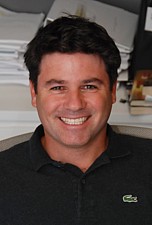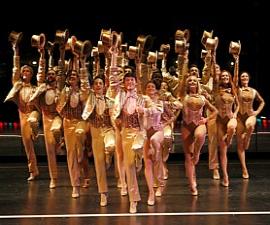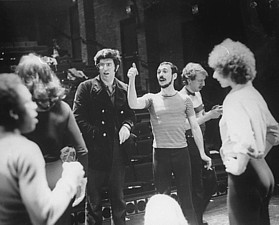
Close Encounters of the Celebrity Kind...
In Step with Every Little Step Directors Adam Del Deo and James D. Stern
Expanded Edition of 5-13-09 Windy City Times Interview
by Richard Knight, Jr.
Expanded Edition of 5-13-09 Windy City Times Interview
by Richard Knight, Jr.
Del Deo, Stern, Marvin Hamlisch and Michael Bennett rehearsing in 1975 with the original cast, the exuberant 2006 revival cast
When the revival of A Chorus Line was in the talking stages in early 2006, producer John Breglio approached filmmakers Adam Del
Deo and James D. Stern about documenting the audition process. The co-directors, who had previously worked together on several
films including The Year of Yao, a basketball documentary, would seem an unlikely choice. But Stern is also a longtime theatre
producer and Del Deo a confirmed Chorus Line fan. Every Little Step, the resulting film opening this Friday in Chicago, which
combines the long audition process to cast the revival and a history of the groundbreaking first production in 1975, conceived by the
late director-choreographer Michael Bennett (who succumbed to the AIDS virus in 1987), is tremendously entertaining. Part reality
show, part history lesson, the movie is indeed a singular sensation.
WINDY CITY TIMES (WCT): For such “A Chorus Line” junkie as myself it was stunning to see and hear audio from the original tapes
with the dancers and Michael Bennett that formed the basis of the show – how did you get access to them?
JAMES D. STERN (JS): John Breglio who was the producer of the revival and Executive Producer of the film was the executor of
Michael Bennett’s estate. Michael had always said to John, “You know, I hate this movie of A Chorus Line that Richard Attenborough
did. If anybody ever did a movie it should be a documentary not a feature.” John always remembered that and he’d seen our film
So Goes the Nation and since I’ve produced 16 Broadway and Off-Broadway shows I knew John through the years and so he called to
see if we’d be interested in doing this and when he told us that we’d have access to the tapes I was incredibly excited and I called
Adam.
ADAM DEL DEO (ADD): Yes, Jim gave me a call and it was great to think about being involved in the revival of such an iconic show.
What was also interesting cinematically was an opportunity to follow dancers through New York going through an audition process
trying to get a job “on the line.” There was a natural mirror in place with what Michael Bennett originally created with A Chorus Line.
The audio tapes were a wonderful element to be able to add to help bring the original production back to life.
WCT: It’s stunning to hear those and it’s also stunning to see clips of Donna McKechnie, who starred in the original, from the
archival tape of the original production. I mean that’s unheard of. You have to go to Lincoln Center to see that tape and it’s one at
a time in a little booth. How did you get permission to include that material?
ADD: That was very much a process. We dealt with Lincoln Center and all the unions had to sign off on that footage. In addition,
this was the first time that Equity allowed cameras to record the audition process from beginning to end.
WCT: Did Equity impose any kind of conditions? You caught some really intimate moments captured over a long period of time.
JS: They didn’t but what we did do was go in ahead of time and talk to them about our vision of the film and they had, I think, a
level of trust because I had produced so many Broadway shows and want to produce again (laughs). This wasn’t going to be any
sort of “American Idol, let’s make fun of the performers,” kind of thing.
WCT: As you shot the initial auditions did you feel the ghosts of Michael Bennett and Bob Fosse’s famed All That Jazz opening
sequence hanging over the process?
JS: I did. Boy, you’re very smart to say that. No one’s actually mentioned Fosse who I think is actually a kind of spectral figure in
all of this.
WCT: You’re kidding?!
JS: No, no one’s mentioned Fosse and he’s always in my thoughts. Obviously not as much as Michael but he’s always there. My
favorite line in the movie is when Michael says, “I wish I didn’t care so much but I don’t think I could ever do that” and I swear to
God to me that is as much Fosse as it is Bennett. They were rivals and close and intertwined and everything else. I always felt
Michael was there and kind of watchful and for me, the proudest moment I’ve had in the entire process was when we screened the
movie in Toronto. We’d never had an audience and there was a five minute standing ovation for the movie and afterwards, Donna
(McKechnie) got up and said, “Not only do I love this film but I know that Michael would have loved this film, too.”
WCT: Can you just talk about the logistics of following all these dancers over, what, eight months? Did you have a huge crew?
ADD: We had a significant crew; yes we had up to eight cameras on any given day. The logistics were pretty comprehensive and we
had a lot of great field producers; a lot of fantastic and hard working cameramen. We shot over 500 hours of footage and that
didn't include the archival material. We knew that to do this film right we would have to cover a lot of bases. We were lucky to have
the resources to do that.
WCT: There must have been high and low points for each of you during the shoot – can each of you talk about one of those?
JS: Well obviously Jason Tam performing the monologue (of the gay character) was a great, great high point but there were others
that were smaller that were also incredible. Certainly the first time I heard the Michael Bennett tapes was a personal high point.
Interviewing McKechnie was a high point.
ADD: I would agree – Jason’s audition and capturing the reaction of the production crew at the table was like capturing lightning in a
bottle – a documentary gold moment. I also really enjoyed covering Baayork Lee who created the character of Connie in the original
and now 30 plus years later she’s the choreographer for the revival and she’s part of the time that’s casting the role she played and
not everyone’s agreeing on who should play the part. I thought that kind of layering and those kinds of moments were really
interesting. We had incredible respect for the dancers and what they go through. The more difficult days were in the edit room;
going through an extensive trial and error period.
WCT: With all that footage, what will we see on the DVD? There must be some fascinating subplots that had to be removed for
time.
JS: There are but we’re not sure what that’s going to be. We had a whole section on Michael which was more personal which we
ultimately didn’t use, there was a section on how A Chorus Line changed New York and a lot more. There’s plenty to choose from.
WCT: Jim, what kind of show do you think Michael Bennett would be doing today?
JS: That’s a great question. Michael was particular – he was very much a creature of this world. His greatest work was “of this world”
whether it was Chorus Line or Dreamgirls or even dating back to Follies. First of all, I think he would have done films. Not
exclusively by any means but he would have explored it. He directed Chorus Line in a lot of ways like a film – he used montage,
lighting, and other film effects. I think he would have also continued to do new shows but I think that the shows would have been
kinetic and less like traditional book shows like The Producers. I think Michael would have done things that more of a high octane
feel to it.
WCT: “Spring Awakening,” perhaps?
JS: Yes, something like that, exactly.
WCT: So you’ve done a film on basketball and Broadway, what next?
ADD: We’re interested in entrepreneurs and we’d love to do a film on Steve Jobs and we have a dialogue going on with members of
his camp. That’s at the top of the list but we’re going to figure out something pretty quick.
WCT: Why out of all the Broadway classics, all the shows to choose from, why document the history and revival of A Chorus Line?
JS: The reason is that this show allowed the film to be elevated beyond just doing a film about a specific show. This allowed us to
do a film about people’s hopes, dreams, the creative process – because it was created in an organic fashion without a workshop – so
therefore, we were able to take a subject matter and use it as a jumping off point. Documenting The Producers or Hairspray would
have been great but the subject matter and the significant impact A Chorus Line had and continues to have on Broadway just lent
itself to this type of project. Also, going from stage to film is tricky and with all the dance built into the show and because it moves
so quickly, it’s a natural.
Deo and James D. Stern about documenting the audition process. The co-directors, who had previously worked together on several
films including The Year of Yao, a basketball documentary, would seem an unlikely choice. But Stern is also a longtime theatre
producer and Del Deo a confirmed Chorus Line fan. Every Little Step, the resulting film opening this Friday in Chicago, which
combines the long audition process to cast the revival and a history of the groundbreaking first production in 1975, conceived by the
late director-choreographer Michael Bennett (who succumbed to the AIDS virus in 1987), is tremendously entertaining. Part reality
show, part history lesson, the movie is indeed a singular sensation.
WINDY CITY TIMES (WCT): For such “A Chorus Line” junkie as myself it was stunning to see and hear audio from the original tapes
with the dancers and Michael Bennett that formed the basis of the show – how did you get access to them?
JAMES D. STERN (JS): John Breglio who was the producer of the revival and Executive Producer of the film was the executor of
Michael Bennett’s estate. Michael had always said to John, “You know, I hate this movie of A Chorus Line that Richard Attenborough
did. If anybody ever did a movie it should be a documentary not a feature.” John always remembered that and he’d seen our film
So Goes the Nation and since I’ve produced 16 Broadway and Off-Broadway shows I knew John through the years and so he called to
see if we’d be interested in doing this and when he told us that we’d have access to the tapes I was incredibly excited and I called
Adam.
ADAM DEL DEO (ADD): Yes, Jim gave me a call and it was great to think about being involved in the revival of such an iconic show.
What was also interesting cinematically was an opportunity to follow dancers through New York going through an audition process
trying to get a job “on the line.” There was a natural mirror in place with what Michael Bennett originally created with A Chorus Line.
The audio tapes were a wonderful element to be able to add to help bring the original production back to life.
WCT: It’s stunning to hear those and it’s also stunning to see clips of Donna McKechnie, who starred in the original, from the
archival tape of the original production. I mean that’s unheard of. You have to go to Lincoln Center to see that tape and it’s one at
a time in a little booth. How did you get permission to include that material?
ADD: That was very much a process. We dealt with Lincoln Center and all the unions had to sign off on that footage. In addition,
this was the first time that Equity allowed cameras to record the audition process from beginning to end.
WCT: Did Equity impose any kind of conditions? You caught some really intimate moments captured over a long period of time.
JS: They didn’t but what we did do was go in ahead of time and talk to them about our vision of the film and they had, I think, a
level of trust because I had produced so many Broadway shows and want to produce again (laughs). This wasn’t going to be any
sort of “American Idol, let’s make fun of the performers,” kind of thing.
WCT: As you shot the initial auditions did you feel the ghosts of Michael Bennett and Bob Fosse’s famed All That Jazz opening
sequence hanging over the process?
JS: I did. Boy, you’re very smart to say that. No one’s actually mentioned Fosse who I think is actually a kind of spectral figure in
all of this.
WCT: You’re kidding?!
JS: No, no one’s mentioned Fosse and he’s always in my thoughts. Obviously not as much as Michael but he’s always there. My
favorite line in the movie is when Michael says, “I wish I didn’t care so much but I don’t think I could ever do that” and I swear to
God to me that is as much Fosse as it is Bennett. They were rivals and close and intertwined and everything else. I always felt
Michael was there and kind of watchful and for me, the proudest moment I’ve had in the entire process was when we screened the
movie in Toronto. We’d never had an audience and there was a five minute standing ovation for the movie and afterwards, Donna
(McKechnie) got up and said, “Not only do I love this film but I know that Michael would have loved this film, too.”
WCT: Can you just talk about the logistics of following all these dancers over, what, eight months? Did you have a huge crew?
ADD: We had a significant crew; yes we had up to eight cameras on any given day. The logistics were pretty comprehensive and we
had a lot of great field producers; a lot of fantastic and hard working cameramen. We shot over 500 hours of footage and that
didn't include the archival material. We knew that to do this film right we would have to cover a lot of bases. We were lucky to have
the resources to do that.
WCT: There must have been high and low points for each of you during the shoot – can each of you talk about one of those?
JS: Well obviously Jason Tam performing the monologue (of the gay character) was a great, great high point but there were others
that were smaller that were also incredible. Certainly the first time I heard the Michael Bennett tapes was a personal high point.
Interviewing McKechnie was a high point.
ADD: I would agree – Jason’s audition and capturing the reaction of the production crew at the table was like capturing lightning in a
bottle – a documentary gold moment. I also really enjoyed covering Baayork Lee who created the character of Connie in the original
and now 30 plus years later she’s the choreographer for the revival and she’s part of the time that’s casting the role she played and
not everyone’s agreeing on who should play the part. I thought that kind of layering and those kinds of moments were really
interesting. We had incredible respect for the dancers and what they go through. The more difficult days were in the edit room;
going through an extensive trial and error period.
WCT: With all that footage, what will we see on the DVD? There must be some fascinating subplots that had to be removed for
time.
JS: There are but we’re not sure what that’s going to be. We had a whole section on Michael which was more personal which we
ultimately didn’t use, there was a section on how A Chorus Line changed New York and a lot more. There’s plenty to choose from.
WCT: Jim, what kind of show do you think Michael Bennett would be doing today?
JS: That’s a great question. Michael was particular – he was very much a creature of this world. His greatest work was “of this world”
whether it was Chorus Line or Dreamgirls or even dating back to Follies. First of all, I think he would have done films. Not
exclusively by any means but he would have explored it. He directed Chorus Line in a lot of ways like a film – he used montage,
lighting, and other film effects. I think he would have also continued to do new shows but I think that the shows would have been
kinetic and less like traditional book shows like The Producers. I think Michael would have done things that more of a high octane
feel to it.
WCT: “Spring Awakening,” perhaps?
JS: Yes, something like that, exactly.
WCT: So you’ve done a film on basketball and Broadway, what next?
ADD: We’re interested in entrepreneurs and we’d love to do a film on Steve Jobs and we have a dialogue going on with members of
his camp. That’s at the top of the list but we’re going to figure out something pretty quick.
WCT: Why out of all the Broadway classics, all the shows to choose from, why document the history and revival of A Chorus Line?
JS: The reason is that this show allowed the film to be elevated beyond just doing a film about a specific show. This allowed us to
do a film about people’s hopes, dreams, the creative process – because it was created in an organic fashion without a workshop – so
therefore, we were able to take a subject matter and use it as a jumping off point. Documenting The Producers or Hairspray would
have been great but the subject matter and the significant impact A Chorus Line had and continues to have on Broadway just lent
itself to this type of project. Also, going from stage to film is tricky and with all the dance built into the show and because it moves
so quickly, it’s a natural.




